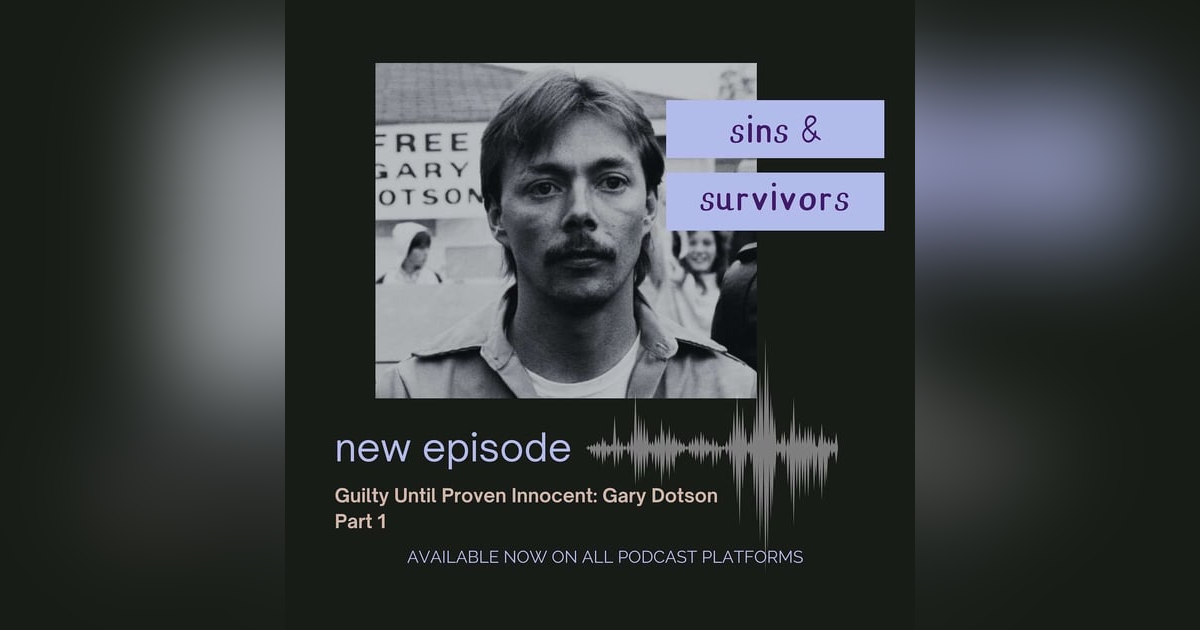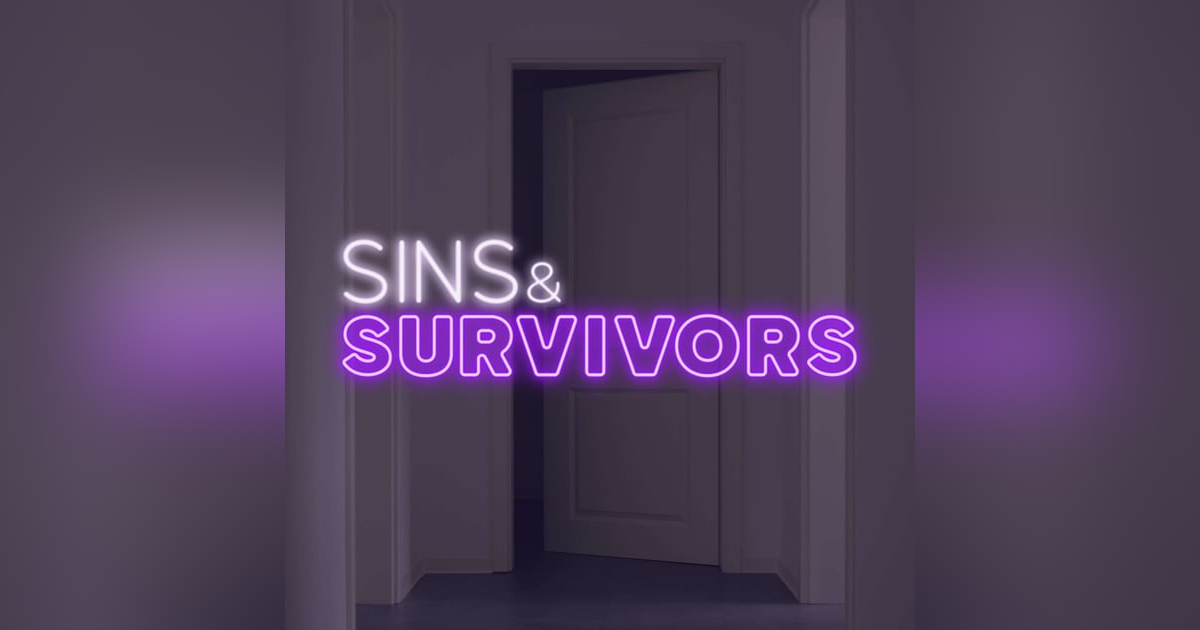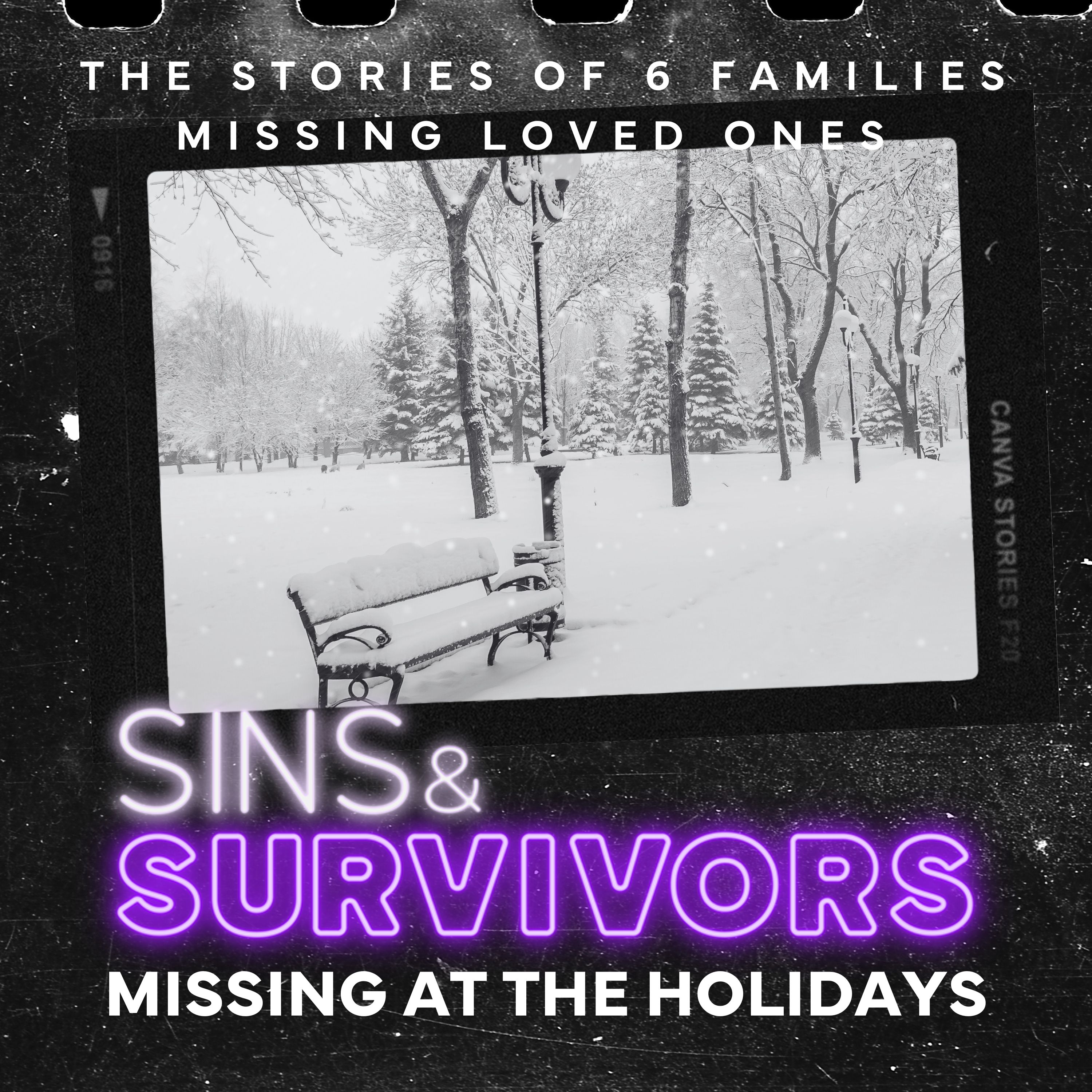Guilty Until Proven Innocent - Gary Dotson - Part 1

Let us know what you think about the episode
In this episode, Shaun and John introduce the case of Gary Dotson, the first person to be exonerated through the use of DNA evidence. The episode delves into Gary's background, including his troubled upbringing, and brushes with the law. In 1977, Gary was accused of rape by Cathleen Crowell. Despite having a seemingly solid alibi, Gary was convicted and sentenced to two consecutive prison terms of 25-50 years.
What happened when in 1985, Cathleen came forward and said she made the whole thing up?
Shaun and John detail the complications and smear campaign that followed Cathleen's recantation.
Sources: https://sinspod.co/episode8sources
Domestic Violence Resources
http://sinspod.co/resources
Click here to become a member of our Patreon!
https://sinspod.co/patreon
Visit and join our Patreon now and access our ad-free episodes and exclusive bonus content & schwag!
Apple Podcast Subscriptions
https://sinspod.co/apple
We're now offering premium membership benefits on Apple Podcast Subscriptions! On your mobile device
Let us know what you think about the episode
https://www.buzzsprout.com/twilio/text_messages/2248640/open_sms
Disclaimer: This post contains affiliate links. If you make a purchase, I may receive a commission at no extra cost to you.
Become a supporter of this podcast: https://www.spreaker.com/podcast/sins-survivors-a-las-vegas-true-crime-podcast--6173686/support.
In 2023, we take it for granted that we won't get convicted of a crime that we didn't commit because of how advanced forensic science is, and because of the use of DNA analysis.Of course, that isn't true, and that's why it's so important that the Innocence Project exists.
Before 1989, however, there was no hope of exoneration because of DNA evidence, and shady expert testimony sent many innocent people to prison without any hope of ever clearing their names. The very first person who who was ever cleared through the use of DNA evidence was Gary Dotson, who served six years in prison for a rape he didn't commit.
You might recognize the name Gary Dotson because he's the first husband of Camille Dardanes Dotson, who we discussed in detail in our previous two episodes. She disappeared several years after divorcing Gary and leaving the Chicago area to relocate to Las Vegas. And while he is in no way suspected in her disappearance. he was definitely abusive towards Camille and her daughter Ashley, and nothing we cover here is meant to excuse that. Over the next two episodes, we'll take a deep dive into his life, case, and history.
Hi and welcome to Sins and Survivors, a Las Vegas true crime podcast where we find on cases that deal with domestic violence. I'm your host, Shaun, and with me, as always, is the one and only John
I am the only John in the room.
So for the past two weeks, we've been covering the case of Camille Dardane Dotson, who, as you recall, went missing from Las Vegas in 1994 and hasn't been seen since. Her daughter, Ashley has been searching for years now with the help of the community, especially her friend, Gabby. Ashley and Gabby are still working hard every day to find Camille and get the word out about her disappearance so they can have answers one day, and we really appreciate our listeners sharing the details of the case and supporting Camille's family on social media.
As we researched this case, we learned about the story of one of the key people in Camille's life, Gary Dotson, who is also Ashley's father. Their turbulent relationship did not end well. It ended with Camille filing for divorce in 1989 and moving with Ashley to Las Vegas.
Camille didn't have much in the way of job prospects here in Las Vegas, so she started tending bar. Unfortunately, she fell in with a bad crowd and progressed from bartending into sex work and then fell into drug use.
Even more unfortunately, her second husband, Cruz Ruiz, was also abusive, as was the man she was with after that, a man named Kiko Fernandez. She disappeared in September of 1994,
and we hope for her return.
All of this happened to Camille long after she was separated from Gary. What we realized is that, although Gary has a history of abuse against Camille, his story is an important one in the context of true crime and the pursuit of justice. So, now it makes sense. sense to cover his story.
Gary was born on August 5, 1957. He's 66 years old today in 2023. He was born in a suburb of Chicago called Country Club Hills, Illinois, and lived with his mother Barbara and three sisters, Laura, Debbie, and Gail, and his brother John.
Gary didn't finish high school and worked at a landscaping company. He also had frequent brushes with the law between 1971 and 1977 for things like truancy and even contributing to the sexual deviancy of a minor. In that case, a mother caught Gary in a parked car with her daughter and decided to press charges, but then withdrew the complaint the next day. In one story we read, he got caught in high school with a bottle of southern comfort,
but, of course he was adamant that he hadn't been drinking. However, it seems like alcohol became his drug of choice quite early in his life and it remained a problem for him long into adulthood.
I think it's safe to say one of, if not the single most important defining event of Gary's life occurred in 1977 when, at 20 years old, he was accused of rape by a 16 -year -old named Cathleen Crowell, who he previously did not know and had never even met before Cathleen was born in Illinois in 1961 making her four years younger than Gary Cathleen had it rough growing up. Her mom had mental health and substance abuse issues mostly alcohol abuse.
Cathleen said that she was neglected by both her parents who were divorced She had two brothers who were eight and ten years older than she was, and her mother often had them take care of her. She recounted a story where because her brothers just didn't know how to take care of her, which isn't surprising because they were basically children themselves. When she was like toddler age, they tied her to a trash can in a park rather than trying to babysit her.
Her father at one point got engaged to a new woman, but this girlfriend, or fiancé, did not want children and was very nasty to Cathleen and her brothers. Eventually, her father left her in the care of a woman who Cathleen called her aunt for an overnight. He called the next day and asked the woman to keep her for a few weeks.
Then after a few weeks, he called and asked if she could take Cathleen permanently. Cathleen later commented that she went to stay for the night, but never ended up leaving. leaving. It wasn't really great for Cathleen there, however, either. This aunt had health problems, so she used Cathleen as her personal Cinderella, doing chores around the house. She was not allowed contact with her mother or her brothers. She wasn't really allowed to have hobbies, or do sports, or go to friends' houses. She even commented that she attempted to run away, and even attempted suicide on the occasion.
Finally, and happily for Cathleen, the aunt sent her to live with the aunt's granddaughter and the daughter's husband. These are the people that Cathleen refers to as her foster family. Finally, Cathleen was allowed to have a childhood. She was doing well in school, she had many friends, she was taking honors classes and was really really thriving. Cathleen even got a job at a Long John Silver's in a mall in Homewood, Chicago.
(attack on Cathleen)
On July 9th, 1977, Cathleen finished up working at the restaurant and left around 8:45 and headed across the parking lot to walk home. Cathleen's account of what happened is quite detailed.
She recounted that as she was walking, a car with three men in it approached her causing her to jump out of the way and fall. Two of the men then jumped out of the car and threw her in the backseat. One of the men got in the backseat with her, and according to her account, he tore her clothing and raped her, and after that, they attempted to carve letters into her stomach using a broken bottle. They then pushed her out of the car and threw her clothes out after her.
Her account goes on to say that she got dressed and started walking home. and came across a police cruiser and the cops stopped to help. She recounted the nearly two hour or a deal from around 8:45 p .m. to 10:45 p .m. to the officer. The officer brought her to the hospital where she was examined and evidence was gathered. They discovered bruising and trauma in her groin area as well as scratches on her stomach and swelling on her head. Cathleen worked with a sketch artist for a few days, and on July 15, 1977, she identified Gary Dotson as her attacker from a photo in a mug book, and then later picked him out of a lineup at the Homewood police station.
Gary ended up losing his landscaping job, but between his arrest and the trial he worked as a window washer and a night porter at Burger King. Interestingly, no members of his family were very worried. because they were all sure that Gary was innocent.
(Gary's Alibi - 8:18)
It makes sense that no one close to him was very worried because Gary had a solid alibi for the Night of the Rape, which remember occurred between approximately 8:45 p .m. and 10:45 p .m. when Cathleen was picked up by the police officer. Gary was hanging out that night with several friends, eventually sleeping in the back seat of a car while his friends went to a party because he was tired.
Later at the trial four of his friends corroborated his alibi, importantly asserting that they were hanging out at one of their mother's houses until 9 p.m. and two others stated that they drove Gary home between 12 a.m. and 12:30 a.m. Gary was charged with rape and kidnapping and the trial started two years later in 1979.
(Gary's Trial 9:00)
The trial took place in Cook County Illinois, and throughout the case, Cathleen was seen as credible. Her story was very detailed, and her injuries seemed to align with the story she was telling. One interesting fact was that, in her composite sketch, she made no mention of a mustache. But per Gary's mother, Barbara, Gary had had a mustache since he was about 15 years old.
The prosecution had an expert witness named Timothy Dixie. Dixon from the Illinois training and applications laboratory who testified that the pubic hairs found in Cathleen's underwear were "macroscopically similar" to Gary's hair and dissimilar to Cathleen's, suggesting a possible common origin. He also testified that according to his analysis only one in ten men could have been the source of the semen found on Cathleen's underwear and Gary Dodson was included in that.
That assertion was later debunked, and it was proven that nearly two and three men could have been the source, so this was nowhere near conclusive in nature.
As for the defense, they did not object to the transparently false testimony offered by Tim Dixon, and little was made about the mustache discrepancy. Apparently, per Illinois law, a discrepancy like that can be overlooked in an instance like this, however.
Additionally, police never even produced the car in which Cathleen said she had been raped. Her description of the car didn't match any of the cars owned by Gary or the friends he was with that night. And as previously mentioned from his alibi, it's quite solid.
I want to say here that none of Gary's friends or any other accomplices were identified or charged, even though Cathleen said that it was a group of three men who attacked her. At the end of the trial, Gary was found guilty and sentenced to two consecutive prison terms of 25 to 50 years.
(11:10 - Cathleens Recantation)
Here's where things really start getting complicated. In March of 1985, Cathleen comes out and completely recants her accusation against Gary. In fact, she says she was never raped at all, that she made it all up. And before I go into this part, I just want to remind everyone that Cathleen was 16 years old when she accused Gary of rape in 1977.
So now she's 24 years old and she's explaining to the press and to anyone who will listen that she had had sex with her boyfriend, David Byrne, and was terrified of being pregnant and being thrown out of her home.
As we stated before, the foster family she was living with provided her a sense of stability. So fearing pregnancy, she concocted the story, tore her clothing, injured herself, cut herself with that glass bottle and planned to walk away. home. She stated she never intended to go to the police or have the police involved at all. She planned to just lie to her foster parents and it was just bad luck, I guess, that the police saw her walking home and saw how disheveled she was and they stopped her.
She stated that she "didn't identify anyone because I didn't want to identify anyone." In my the boy I had actually been with was blonde. I knew that they had taken pubic hair samples for evidence and I thought, "Oh boy, he's got to have blonde hair." In my description, I was detailed because the more details you give, the harder it is to pick out a specific person. If you're general, almost anybody can fit the description." She kind of made the sketch up for the sketch artist as she went along. She didn't really think that they could find her. attacker because he didn't exist.
She was caught up in her lie and it just snowballed when the police brought her a photo of Gary and said something to her like, "Look again, real close." She felt compelled to say it was him and she hoped he had a good alibi.
So the question you might be asking now is how did a 16-year-old come up with a story that fooled basically everybody, the cops, the ER physician, the judge, everybody, and how did she come up with a story that was so convincing?
Well, the answer is not only is Cathleen a very good storyteller, and she's very convincing and comes across very credible. She didn't make up the story herself. She took a story from a 1974 romance novel called "Sweet Savage Love" written by Rosemary Rogers.
In 1985, Cathleen admitted that she just used that story, the vivid rape scene from that novel, as the basis for her lie. If you were to read that scene from the novel, she just made it modern times instead of it being a carriage she used a car as the location for the rape, but she just plagiarized it basically from this author.
This was self-preservation for her. She knew her life was over if her lie was discovered. For the two years leading up to the trial, Cathleen said said she suppressed her guilt. She's called herself manipulative and selfish, and despite knowing her actions were wrong, fear of consequences led her to maintain the lie during the trial.
Her testimony was rehearsed with help from the prosecutor's office, and she was both scared and embarrassed on the witness stand and afraid that she'd be found out. After the trial, Cathleen said she tried to put the whole thing out of the way. of her mind, but couldn't forget how numb she had felt when the verdict was read, nor could she forget how Gary had cried.
About a year after the trial ended, Cathleen began dating a guy named David Webb, who was a senior at her high school. After graduation, she went on to junior college, and then she and David Webb moved together to New Hampshire, and in July of 1981, they got married.
There is an interesting fact about their wedding that I think demonstrates that Cathleen had good reason to be concerned about how her foster parents would have treated her if they found out she was having sex at age 16, especially if she was pregnant. When Cathleen got married to her husband David, she was 20 years old.
Her foster parents were invited, but did not come to the wedding because Cathleen had lived with David before getting married to him as David and Cathleen built their new life in New Hampshire, the two of them joined a church and Cathleen became a born -again Christian, and at some point she started having guilt and regrets about what had happened with Gary.
She confessed to her pastor named Carl Nannini that the rape had not actually happened. He put her in touch with a lawyer named John McLario. She had been quoted as saying, "All I can say is I created a monster of a lie and now I'm trying to get rid of it. I'm trying to get rid of it." to make it right." And quote, "His life is worth more than my keeping silent," unquote. MacLario got in touch with the Cook County prosecutors, but they did not seem interested in her recantation of the rape accusation.
After that, they reached out to the press. They contacted Jim Gibbons, who was a local on -air reporter, and he broke the story on March 22, 1985. 1985, the story of her recantation.
The Chicago Sun -Times had a front-page article on the recantation, but the Chicago Tribune, which at the time was known to be more of a PR outlet for the Cook County Prosecutor's Office, painted Cathleen in a very unfavorable light, casting doubt on her recantation and characterizing her as "unstable."
And what followed is what I would call a smear campaign against Cathleen and the idea of her recantation. Cathleen's foster mother and father gave interviews to the Tribune casting doubt on her explanations for her recantation by bringing up things like the timing of her menstrual cycle or the last time she had had sex with her then boyfriend.
Cathleen's boyfriend at the time of her accusation against Gary was a young man named David Byrne. He stated that they'd had sex many years ago. times. So he was very skeptical of her claims about, being afraid because it was her first time, um, her foster mother recounted that Cathleen got her period just three days after the rape. Cathleen and her mom, her foster mom were concerned that she could be pregnant from the rape. So when Cathleen told her, Oh, I got my period, this was a big relief, but but that happened before Cathleen went to the police and formally identified Gary. Her biological brother disputed several statements that she made about her childhood that she had given to People Magazine.
In the People Magazine article Cathleen wrote, she gave a very detailed timeline of when and where she was presented with photos of possible suspects, went to the police station to view a lineup, et cetera. And that did not... match the police records. For example, Cathleen claimed she identified Gary from a photo that the police had brought to her home, but police officers and her foster mother said that the police never questioned Cathleen at the house.
Cathleen claimed that her testimony went so smoothly because she had studied her statements from the police interviews and practiced with the help of the prosecutors, but her foster parents told the Chicago Tribune that Cathleen-- Cathleen never did any of that.
The Chicago Tribune published a claim from a "source close to the investigation" that called Cathleen unstable and "calculating evasive and manipulative".
That source was later identified to be an assistant state's attorney who had been involved in the case. So it seems clear that the Tribune and the Cook County's prosecutor's office were probably.probably concerned how they'd look if their star witness in Gary Dotson's case completely recanted her testimony.
(Evidentiary Hearing)
Yeah, it doesn't look good if they completely botched the case. So when Gary heard about Cathleen recanting her rape accusation, of course he immediately requested a new trial. Instead, he was granted an evidentiary hearing and released on a $100,000 bond. The hearing was set for April 11th 1985.
At this point, Gary Dawson is obviously extremely excited. His accuser had recanted her accusation, and it seemed clear to him that he'd be set free. So he started making plans for his post -prison life. He even made plans to organize a foundation to help cover fees, "for all the innocent guys in prison".
He made statements to the press that he would... would like to speak with Cathleen once everything was all over to find out why "It's been so long .. why six years later, how could she hold it for so long,".
At the hearing, it was the same judge presiding that had presided over his trial, Judge Samuels. Judge Samuels determined that Cathleen's testimony at the trial was more credible than-- her testimony at the evidentiary hearing, and he ignored several key inconsistencies in her earlier testimony in the trial, including the fact that she said her pants got muddy during the attack but also said she was raped inside the car. She said she scratched behind the attacker's ear but no such injury existed on Dotson. She also claimed that her attacker was clean shaven. as we mentioned before, but Gary had had a mustache since he was 15 years old.
Because of all this,Samuels revoked the bond, and Gary was sent back to prison, reportedly slamming his hand on the table in frustration when he heard Samuels' decision. Remember that if the judge had simply ordered a new trial, there's little chance Gary would have been convicted because Cathleen wouldn't have testified against him. So in spite of Cathleen's insistence and her shameful admission that she had told such an egregious ugly Detailed lie that landed an innocent man in jail The question remained both in the justice system and in the court of public opinion. Did Gary actually do this? Was Gary a young working -class guy that got massively unlucky or was he a violent rapist? Was Cathleen a scared virgin or an unstable perjurer? Was Cathleen lying in 1977 or was she lying now in 1985? And if she was lying now, what motive would she have for doing so?
In our episodes on Camille, we mentioned how Camille had an obsession with Gary. Listening to everything that happened to him before he even met her explains why she was so taken with his story. And Camille always believed Gary was innocent, while her close friend commented with Gary and that she was the one who told him that she was the one who told him that she had an obsession with Gary and that she was the one who told him that Gary was innocent. she didn't get why Camille ever gave a bum like Gary the time of day.
Not everyone agreed with Judge Samuels. By that point, Gary Dotson was a household name and many people were debating his guilt. Years later, Gary reflected on that April 11th hearing and how he had turned to alcohol to cope. Gary said that he, "had learned to live a different way for six years, and that drinking relaxed me, made me more open". He said that he had a six -pack for breakfast the morning of April 11th the day of his evidentiary hearing.
So this concludes part one of Gary's story. We'll pick it up next week with part two where we'll explain how Gary did eventually leave prison and how his life didn't get much better after that. In the meantime be sure to get caught up on parts one and two of Camille Dardane's Dawson story that we covered in episode 6.
Thanks as always for listening and remember what happens here, happens everywhere.







